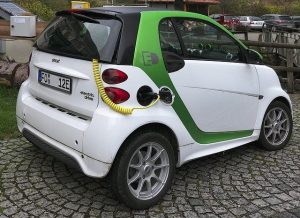Pedro Gerber Machado, a visiting researcher from the University of São Paulo, Brazil, summarises his recent review paper examining the life cycle emissions for road freight transport. The review was carried out in collaboration with the Institute of Energy and Environment at the University of São Paulo, Brazil.
Author: Pedro Gerber Machado
The transport sector is responsible for around 30% of the world’s energy consumption and 16% of greenhouse gases (GHG) emissions. To achieve an energy transition to guarantee net-zero emissions, reducing emissions from road transport is fundamental. Diesel is still the most common fuel used for heavy road transport and freight. While worldwide there is a move towards electric vehicles, their environmental benefit in reducing emissions depends on the area’s electricity sources. Our review paper examines the total environmental life cycle emissions of different fuel options and technologies for road freight transport (trucks) in 45 studies.

Source of electricity
The source of electricity can make a big difference to greenhouse gas emissions. We found that with greenhouse gas emissions, higher values (3,148–3,664 g/km) are found in places where coal has a significant share in electricity generation. Lower emissions are found where renewables have higher percentages in electricity generation (496 g/km). In China, emissions can reach 5,479 g/km since electricity generation “is mostly from coal.”
Compressed Natural Gas (CNG)
For Compressed Natural Gas (CNG) technology, greenhouse gas emissions vary due to differing efficiency and assumptions about methane leakage during natural gas transportation. But future projections are optimistic due to the potential for improvements in controlling methane emissions (514 g/km in 2050).
Biodiesel
In the analysis, biodiesel had a higher energy consumption and higher emissions profile in the production phase equal to diesel, which is the main reason for its low environmental performance.
Hydrogen
The greenhouse gas emissions intensity from hydrogen varies as it is depends on its method of production such as coal gasification, steam methane reforming (SMR), and hydrolysis. The use of carbon capture and storage (CCS) and liquid or gaseous use also influences its final emission profile.
Fuels vs. diesel
On average, the review showed that biogas, fuel-cell hydrogen, and Liquefied Natural Gas (LNG) have lower emissions in their life cycle than diesel, with a chance of a 57% reduction in emissions for biodiesel, 77% for fuel-cell hydrogen, and 100% chance for biogas. Interestingly, even though biodiesel is a renewable source of fuel that receives significant attention due to its capacity to reduce greenhouse gas emissions, in our review, it had a higher average emission than diesel.

Battery electric, hydrogen fuel cells and biogas
We found that if a clean electricity matrix is available, with high renewable energy shares, battery electric vehicles provide the best option. Hydrogen fuel-cells, when hydrogen comes from renewable sources, are also comparable to battery electric vehicles. Biogas can serve as a feedstock for hydrogen production in substituting natural gas in steam methane reform or liquefied for use in Liquid Natural Gas (LNG) trucks.
Further research into biogas emissions, fuel consumption, and its economics is essential. Since biogas production is possible from several sources, it could be suitable for different countries, such as Brazil.
Analysing air pollutants
There is a lack of studies exploring the life cycle of these options when it comes to air pollutants. Even though pollutant emissions in the use phase (for internal combustion options) have received more attention from the scientific community, emissions for the whole life cycle should also be studied. Even so, uncertainties related to the Tank-to-Wheel evaluation can increase the inaccurate values from this side of the analysis and the error propagation, directly impacting the policymakers. For PM2.5, hybrid and LNG options have greater changes in reducing the emissions. Fuel-cell, LNG, CNG, and hybrid trucks have higher chances of reducing nitrogen oxide (NOx) emissions. In contrast, sulphur oxide (SOx) emissions came out inconclusive due to a lack of studies.
But what about the economics…
CNG, LNG, and hybrid trucks were the best options from an economic perspective. CNG has lower life cycle costs and fuel costs in most analyses, with values ranging from 50% lower life cycle costs than diesel to a 2% reduction, to 16% average increase. CNG is the most economical fuel for large fleets that conduct urban operations and can support private infrastructure.
LNG could have a payback time of 2.5 years or lower, considering the price differential mostly in long-haul operations due to its lower fuel costs. However, economic viability could be achieved due to the higher cost of LNG vehicles and maintenance and the limited range of LNG trucks relative to diesel. The studies also showed that the fuel efficiency in LNG trucks could dictate its economic viability. Relative efficiencies of less than 80% reduce the chances of lower costs by 50%.
Finally, hybrid trucks show a total life cycle cost from 10% lower to practically no difference. Although the incremental cost of hybrid trucks is expected to become close to zero in the future, additional investments of more than $35,000 in hybrid technology hinder its viability, especially with low diesel fuel costs.
In the developing world…
The question arises then if the best options regarding GHG and local pollutant emissions will ever be a possibility for developing regions. Even though authors point out that electric trucks could cause an increase in emissions in several places in the world and that it is still necessary to evaluate peak power demand to understand the operational aspects of transport electrification, electric trucks in countries with a high share of renewables have the most radical reductions in GHG. However, being the most expensive options, there is a slight chance that governments in poorer countries or even the private sector will be willing to pay the price, based solely on environmental reasons.
The way to go in these countries has been to continue to depend on diesel. Most recently, the discussion on natural gas use in the transport sector has gained some momentum. Cheaper than other alternative options, natural gas might be an option due to its lower PM emissions, even though other pollutants, or GHG emissions, are higher.
